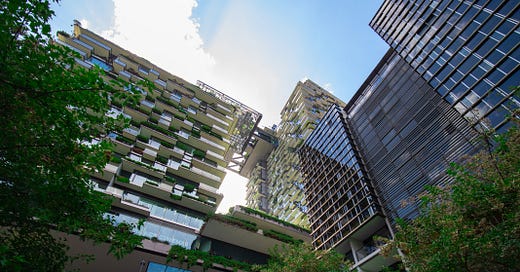Groundswell Property's Market Insights
Investors Pivot as New Housing Surges, Policy Shifts, and Affordability Pressures Mount – Key Insights as at 01 March 2025
Welcome to your weekly edition of Groundswell Property’s Market Insights, where we bring you the latest trends, research, and expert opinions shaping real estate across Australia.
As Australia’s property market continues to evolve, major trends are emerging—from a government-led foreign buyer freeze to rising investor activity in new housing. Meanwhile, stamp duty reform is back on the agenda, and Build-to-Rent developments are scaling up to meet growing demand.
Key highlights this week:
Foreign Buyer Ban: A two-year freeze on foreign buyers of existing homes starts April 1, but experts say it will have minimal market impact.
Stamp Duty Reform Talk: REIA calls for the removal of stamp duty for downsizers, citing its impact on housing mobility.
Investor Shift to New Builds: More investors are choosing house and land packages over off-the-plan apartments.
Public Opinion on Housing Affordability: A survey finds most Australians want government funding for affordable homes over tax breaks for investors.
Build-to-Rent Boom: The sector is accelerating, with thousands of new apartments under construction or in planning across Australia.
As always, our goal is to provide evidence-based insights to help you make informed property decisions—whether you're buying, selling, or simply keeping a pulse on the market. Let’s dive into the data and insights shaping the year ahead.
Foreign Buyer Freeze
The Federal Government is hoping a freeze on foreign buyers will help ease Australia’s housing crisis.
It has announced a ban on overseas buyers of existing Australian homes for two years and will review the effectiveness of the scheme after that.
It will come into effect from April 1, 2025, and stop foreign persons including temporary residents buying established homes in Australia.
But industry analysts say the move will have very little impact on the market.
International real estate technology group Juwai IQI says only about 1600 transactions a year will be impacted.
Managing director Daniel Ho says of the roughly 520,000 home sales per year in Australia, fewer than 5,000 go to foreign buyers, and only about a third of those are existing homes.
That equates to about 1% of all transactions.
Temporary residents will still be able to buy new properties in Australia.
Treasurer Jim Chalmers says the government is also cracking down on land banking by foreign investors to free up land to build more homes more quickly.
Stamp Duty On Agenda
Calls for the abolition of stamp duty are once again on the agenda with the Real Estate Institute of Australia calling for it to be at least removed from older Australians who want to downsize.
REIA president Leanne Pilkington (pictured) says it adds substantially to the cost of transacting and is stopping some people from moving and freeing up larger homes for families.
She says the transition from stamp duty to land tax could be one of the most significant reforms in real estate policy but she admits it is not on the radar of many State Governments.
“While the economic benefits are clear, most state governments remain hesitant to implement such a major change,” she says.
Pilkington says it is a real financial hindrance to buying and selling.
“Effectively, you’re looking at tens of thousands of dollars just in tax every time you move,” she says.
“The impact is that people stay put in homes that don’t suit them anymore. Older people stick around in large homes while young families squeeze into tiny apartments because the cost of moving is just too high.”
This week Queensland axed stamp duty for all first-home buyers purchasing new builds.
New Home Builds on The Up
New home building is set to pick up this year, as investors turn to new house and land packages.
Oxford Economics Australia research predicts total dwelling commencements will increase by 4.5% in FY2025. It also tips another 4.3% increase the following year.
Oxford Economics Australia, head of property and building forecasting Timothy Hibbert says a lot of the demand for new houses is coming from property investors who are buying a larger share of the house and land packages than in the past.
He says that is because there are fewer off-the-plan apartment developments underway, so investors are shifting their focus from units to houses.
“We used to see first home buyers make up a much bigger share, but their numbers have fallen back quite significantly when it comes to house and land purchases,” he says.
Hibbert says in Victoria, 76% and NSW, 71%, more investors took out loans for the construction of dwellings in December 2024 compared to five years earlier.
The trend he says is also emerging in the other states.
Calls to Prioritise Affordability
The majority of Australians want the government to focus spending on affordable home options rather than tax breaks such as negative gearing for investors according to a new survey.
A survey, commissioned by Everybody’s Home, of 2500 voters found almost half wanted the Government to focus on funding affordable homes, while only 17.5% thought tax concessions for investors should be a priority.
More than a third of respondents say housing is their biggest cost of living pressure, followed by groceries (26%), energy bills (16%) and insurance (9%).
Maiy Azize from Everybody’s Home says this could make housing more affordable.
But an analysis by the Property Investment Professionals of Australia (PIPA) says changes to tax incentives are already forcing investors to leave the market and that is not good news for renters.
It says when investors leave the market it reduces the rental pool, making it even harder for renters to find a home and putting upward pressure on rents.
Build-to-Rent Surging
The build-to-rent (BTR) sector is continuing to surge with new figures showing more than 4,300 apartments were added to the market in 2024.
And Knight Frank predicts more will be delivered in 2025 with about 8,900 dedicated BTR apartments under construction in Australia and a further 20,000 approved for development over the next five years.
Victoria is the leader of the sector with 25,538 units either completed, under construction or planned as of the fourth quarter of 2024.
At the same time, New South Wales has 15,089 and Queensland 14,390 units.
Knight Frank’s John Paul Stichbury says the sector has been growing steadily since 2018 with 19,308 apartments either delivered or under construction, and a further 40,191 planned.
He says smaller markets are also embracing Build-to-Rent including the ACT where 1,723 units are either completed, under construction, or planned. Western Australia and South Australia have 1,568 and 1,191 units respectively completed, under construction or planned.
Key Takeaways
Investor behaviour is shifting, with many turning to new house and land packages as affordability pressures intensify.
The government’s ban on foreign buyers and potential stamp duty reforms may slightly reshape market dynamics, but experts argue that systemic supply constraints remain the core issue.
Meanwhile, Build-to-Rent developments are growing in scale, offering a promising solution to Australia’s housing shortage.
With policy changes, evolving investor strategies, and affordability concerns at the forefront, staying ahead of the trends has never been more critical for buyers, sellers, and investors alike.
As always, success in property comes down to having the right information, the right team, and the right strategy. If you want to make your next move with the confidence and preparedness needed to get the best result: Contact Tom on 0439754475
Thanks for joining us. See you next Saturday for more insights. We look forward to supporting you in achieving your property investment goals in 2025
Tom Haigh
Director & Licensed Buyers Agent
Groundswell Property - Established 2015
tom@groundswellproperty.net
0439754475








